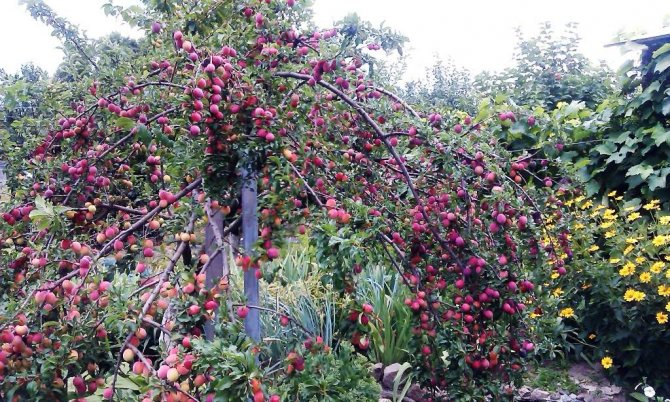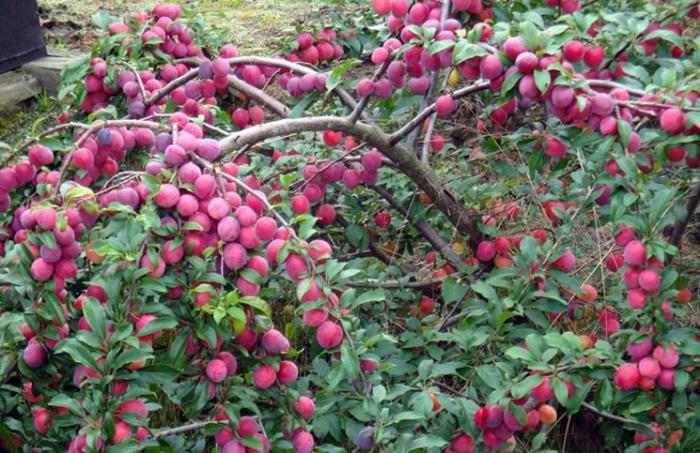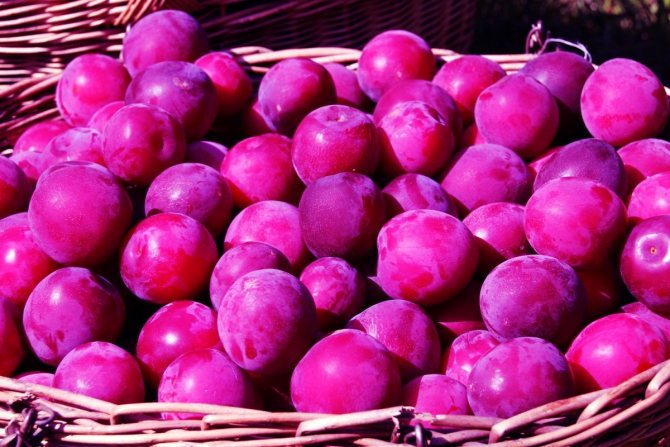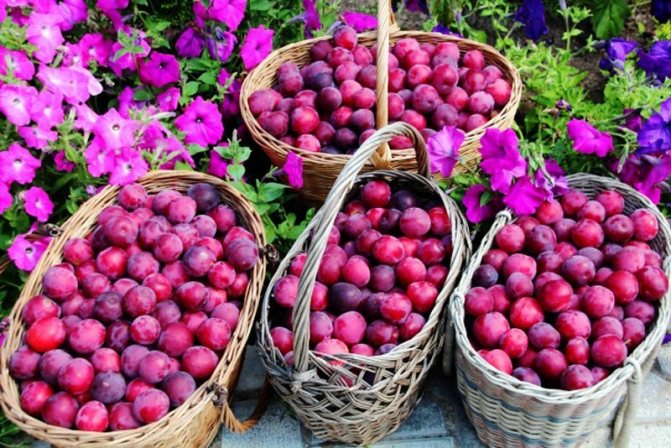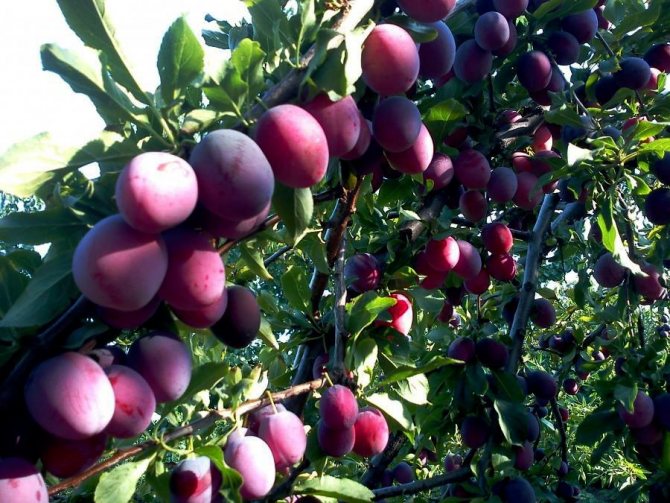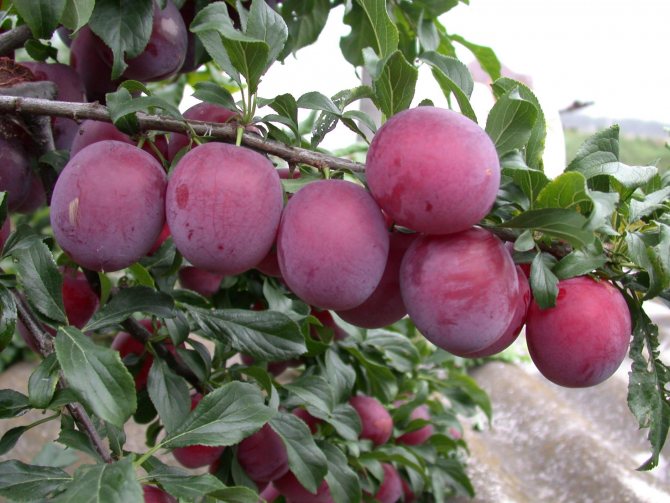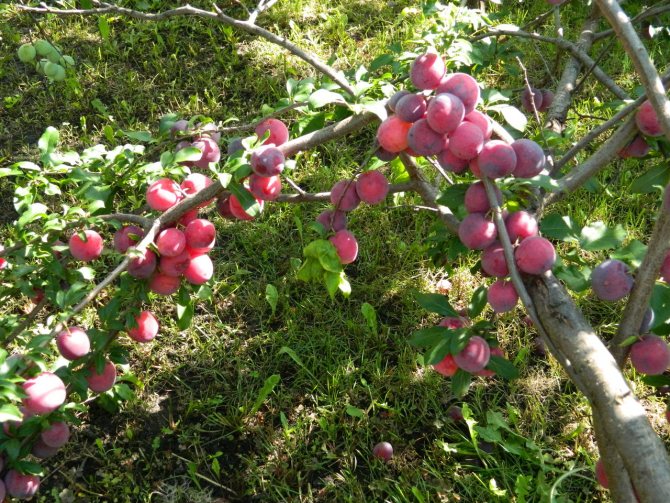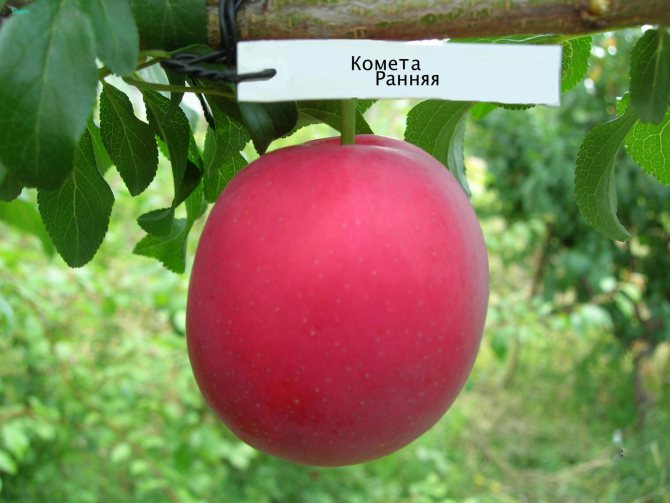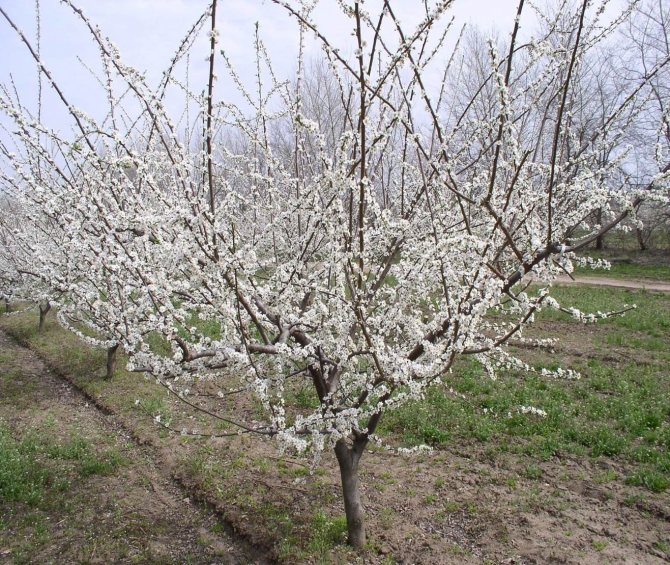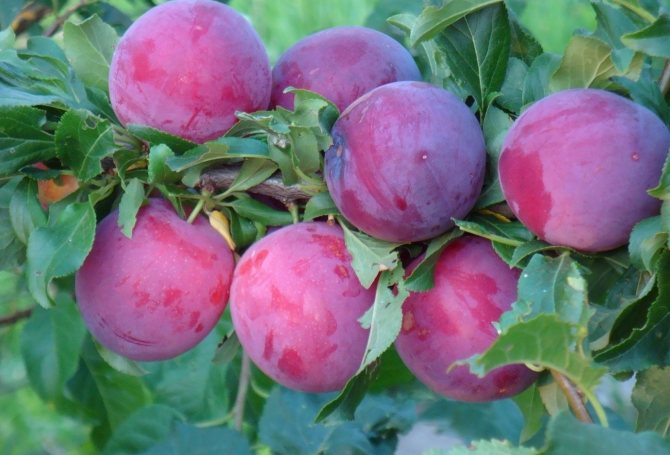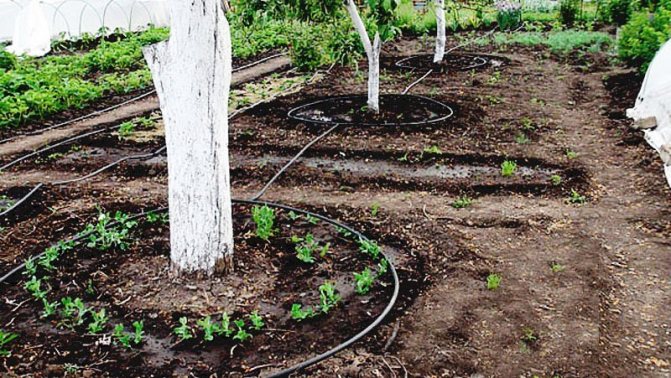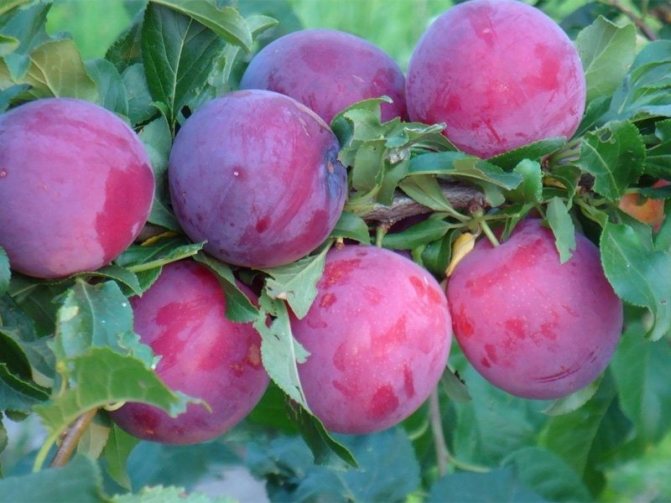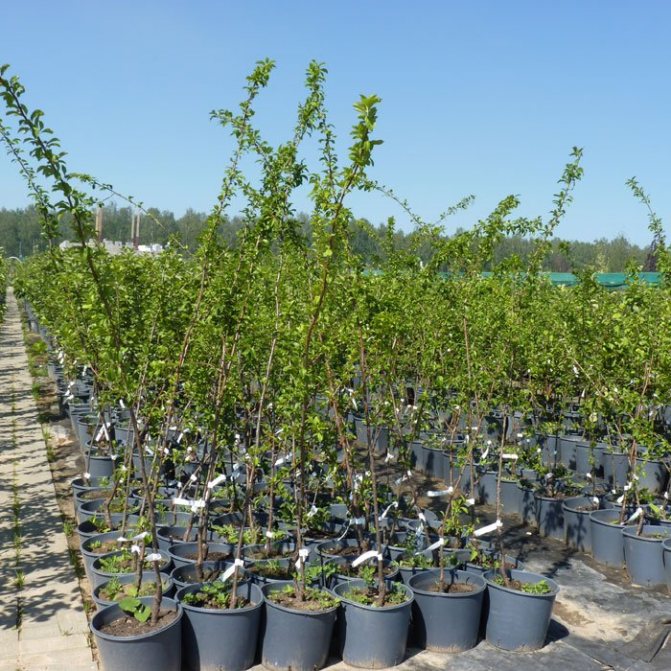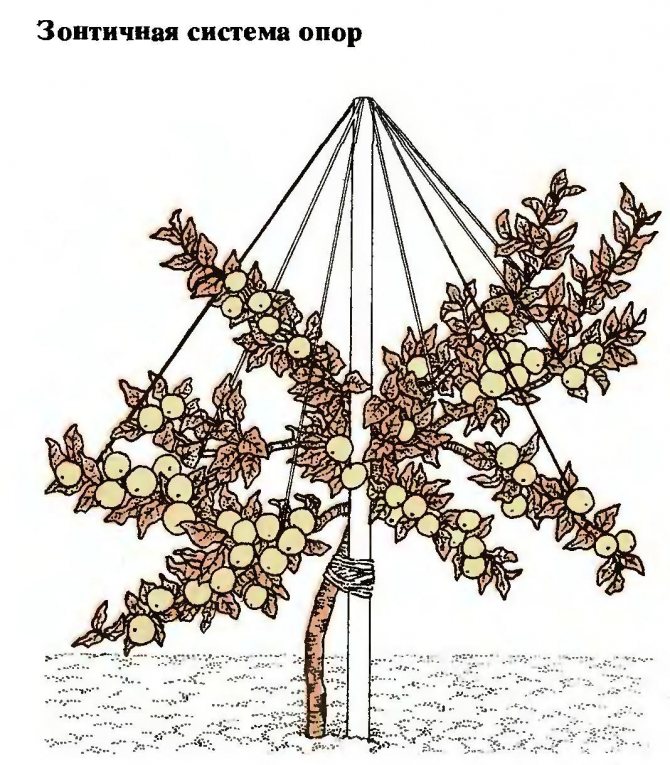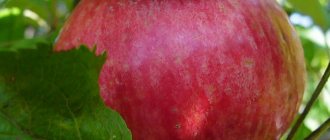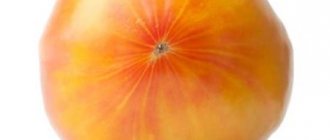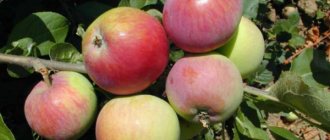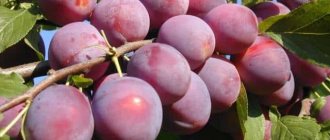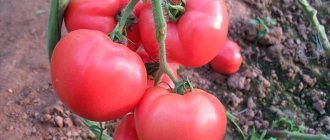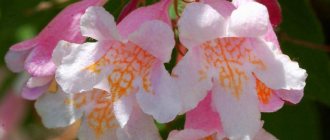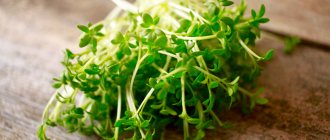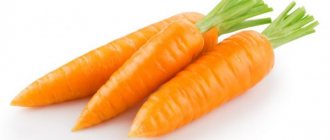Description of the variety
The variety of Russian plum "Kuban comet" is also recognized by many gardeners as decorative. The tree, 2-2.5 meters high, has oval leaves of dark green color. If you do not form it, then in free form it will look more like a shrub.
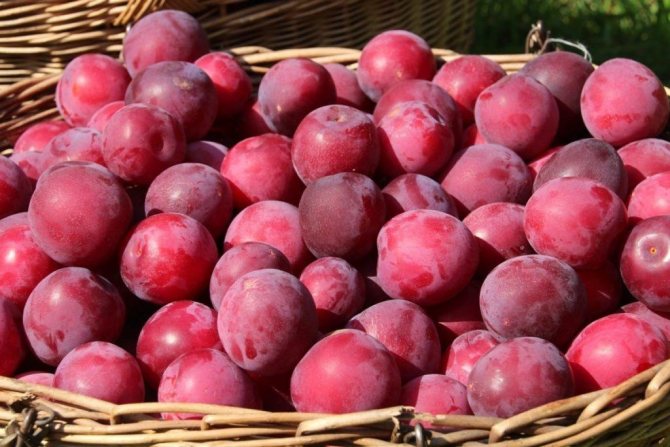
Advice! Variety "Kuban comet" needs to attract insects, as it is not entirely self-fertile. To do this, at the very beginning of flowering, it is sprayed with sweet solutions, for example, honey. Proportions: 1 tablespoon of honey is stirred in 1 liter of water, this amount is calculated for one tree.
The branches are very strong and flexible, capable of withstanding a very large harvest, and have a drooping crown. Blooms in inflorescences, flowers are usually not large.
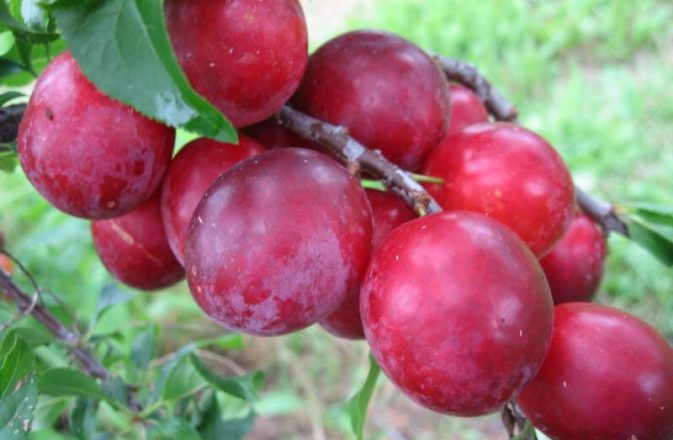

The cherry plum variety "Kuban comet" is self-fertile, as can be seen from the description, photos and reviews, as it has female and male flowers. For a higher yield, you need to plant a number of pollinating varieties, such as:
- Gold of the Scythians;
- Traveler;
- Mara.
The blooming period of the "Kuban comet" cherry plum lasts about 10-12 days, it begins depending on the region of residence: in the south in May-June, colder regions - June-July, the Kuban comet cherry plum blooming period. The first harvest can only be tasted three years after planting.


Cherry plum "Kuban comet" is considered a variety for the southern regions, but judging by the description of the variety and reviews of gardeners, it can be called frost-resistant, since it can withstand frosts up to -35 C degrees, which cannot be said about the fruits. If the spring is cold, the kidneys may freeze.


How and when to plant
The process of planting cherry plum is a responsible business. The further growth and development of the berry tree depends on this.
Dates and choice of location
Planting of cherry plum Kuban Comet can occur both in spring and in autumn. But if you live in the northern regions, then it is better to plant seedlings in the spring. When choosing a place for planting, you need to pay attention to the area that is located on the south side and is well warmed by the sun. Otherwise, the tree will not grow well, and its fruits will not be tasty.
As for the soil, this variety does not like clay or loamy soils. It is best to plant young seedlings on sandy and fertile soil with a neutral acidity level. The level of groundwater occurrence is also important. It should not be higher than 1 m.
The video shows how to plant a tree:
Preparatory work
It is necessary to prepare the pit in advance. Dig it up 2 weeks before planting. But this is on condition that planting work will be carried out in the spring. The size of the recess will be 80x80x80 cm. If several seedlings are planted at once, then a distance of 3-3.5 m must be observed between them.
Fertilize the resulting hole. for this you need to take 5 kg of humus, 250 g of superphosphate, 50 g of potassium sulphide. It is also mono to add lime and ash, if you need to reduce the acidity level of the soil. But fertilizing with nitrogen or fresh humus cannot be used. Send the finished train to the landing pit, filling it by ½.
Planting process
Before sending the seedlings to the planting pit, it is necessary to place the roots in a clay talker. Keep there for 1 hour. You can also use a growth stimulant.Then you need to drive a peg into the hole and lower the seedling there. The planting depth should be such that the bark neck rises 6 cm above the ground.
Now crush the seedling with earth and tamp it. Using a strong rope, tie the cherry plum to the peg. Make a hole near the seedling, which will be at a distance of 40 cm from it. Send 20-40 liters of water there. Once it is absorbed, then mulch with wood chips.
What the earliest pear variety looks like, and what they are called, is described in the article at the link.
It is also worth learning more about the existing pear varieties for central Russia.
You may also be interested in information about the autumn sweet pear variety.
Description of fruits
The fruit of the "Kuban comet" has large, beautiful and regular shapes. The mass reaches up to 50 gr., Are similar in shape to an egg. When fully ripe, it has a rich plum color. The pulp is very fleshy, yellowish-pink in color, the skin has a slight bloom. The stone is poorly separated from the pulp.
Advice!
If you do not have the opportunity to plant 2-4 varieties of pollinators on the site, it is recommended to plant a branch of the pollinator variety on the existing tree.


Cherry plum tastes good when fresh. Jam, jams, compotes are made from it. The fruits are suitable for freezing, while maintaining almost all vitamins perfectly. By the way, one of the most delicious Georgian sauces is made on the basis of cherry plum.
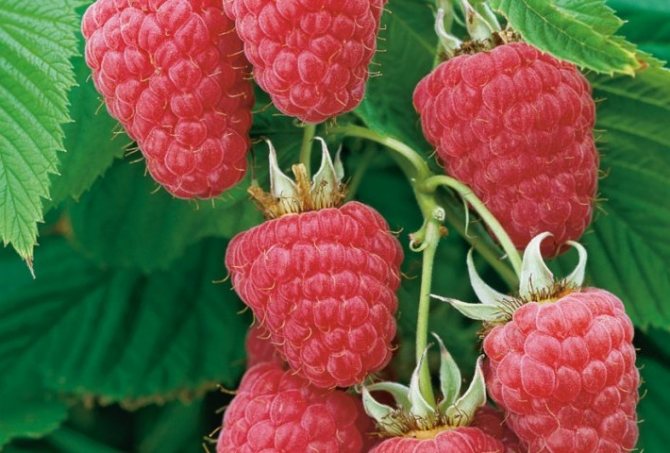

Ripening terms
In the southern regions of Russia, fruits are harvested at the end of July, in the rest it is in August. Fruits can remain on the branches for a very long time and not crumble, while they do not overripe and retain their taste for a long time.
“The Kuban comet is a high-yielding variety. A young plant gives up to 15 kg of fruits per season, an adult - up to 40 kg from one tree.
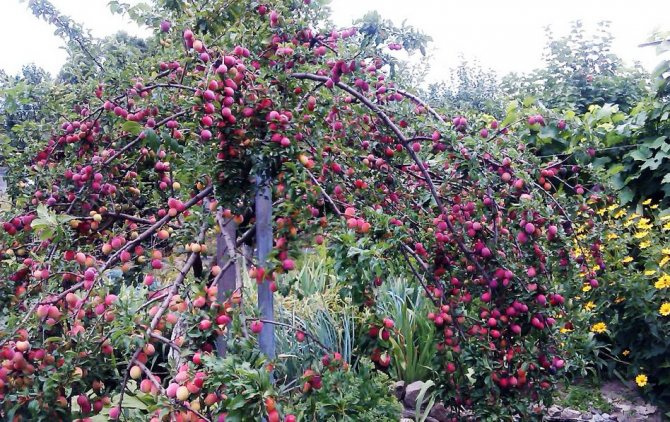

The plum variety "Kubanskaya Kometa" has good shelf life, in a cool place they can stand for about a month without losing their presentation and qualities. Farmers widely use it for cultivation, using pollinator varieties, for sale, since, in addition to long shelf life, it is also perfectly transported and transported over long distances.
Diseases and pests
The Kubanskaya Kometa variety is one of the most resistant to diseases and pests, but nevertheless, if the care is not proper, the tree can get sick:
- red spot;
- gray rot;
- rust;
- gum flow.
Bushes, if not taken in time, are often attacked by pests:
- fruit sapwood;
- moth;
- aphid.
Gray rot
The botrtis mushroom is to blame for the appearance of gray rot on cherry plum. It originates in the soil and plant debris. A lesion can be recognized by withering branches and the appearance of a brown tint, the bark and fruits are covered with growths. The fruits start to rot.
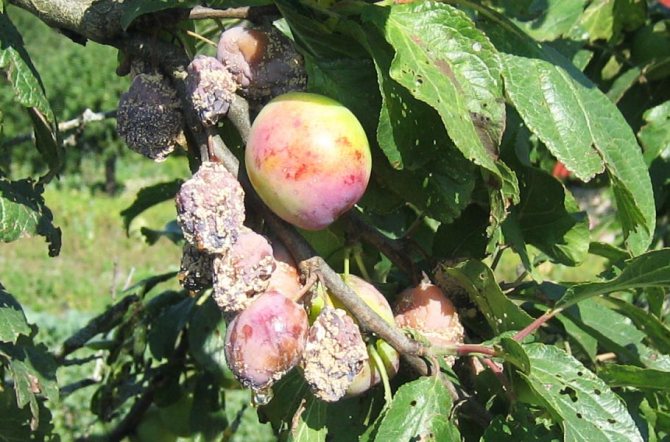

Prevention is carried out before budding, treating trees and soil with a mixture of vitriol and Nitrofenome. After flowering, you can do a second treatment with Kaptan and Kuprozan.
Brown spot
Leaf mildew, or brown spot, is also a fungal disease that can destroy up to 50% of the crop. You can recognize the appearance of the fungus by the leaves, brown spots appear on them, along the edges of which there is a black border, in the middle there is a dark dot. After the appearance of such a defect, the leaves dry very quickly and fall off.


Prevention is done with a 1% solution of Bordeaux mixture, when the buds are just beginning to bloom, re-spraying is carried out 15-20 days after they bloom, copper oxychloride is used for this
Rust
The characteristic features of the appearance of rust are the appearance of rusty spots on the foliage, after a while they turn into pads.To prevent the appearance of a fungal disease, after July 15, the tree should be treated with Aktofit. Re-processing is done after 15 days, with the same drug.


Rust noticeably stops the growth of the tree, if you do not take protective measures, the tree will die.
Gum therapy
It does not belong to fungal diseases, but it does no less harm.
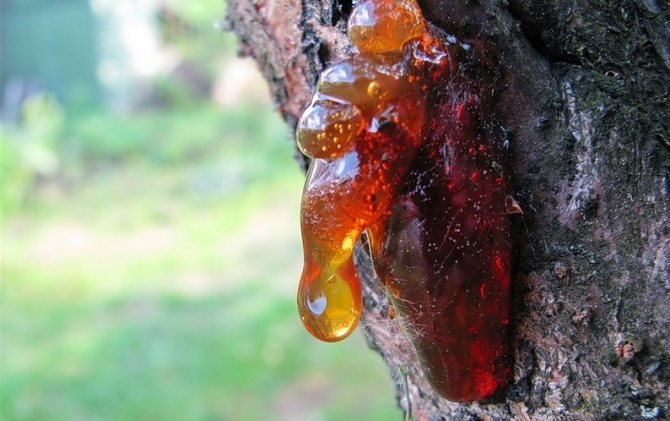

There are quite a few reasons for the appearance:
- severe winter;
- sunburn;
- non-compliance with pruning rules;
- damage to the bark;
- the appearance of a bark beetle.
When examining a tree, you can sometimes notice resin protrusion from under the bark, this is a sign of a disease. When a disease occurs, the gum should be cut off, disinfected with copper sulphate and covered with Negrol resin. After each trimming, the sections should be covered with Petrolatum.
Fruit sapwood
If a gum leak has appeared on the Kuban Comet plum tree, and the branches and trunk are covered with passages, most likely a pest has started - the fruit sapwood. The passages are very narrow, up to about 2 mm in diameter. Pest prevention should be done at least twice a year.
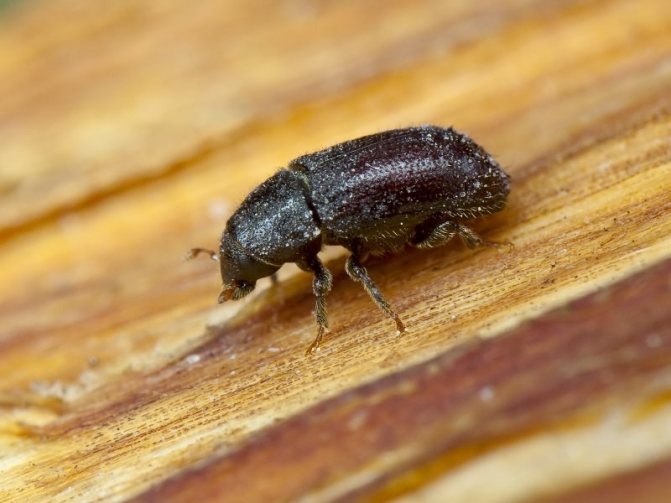

Until the females lay eggs, they eat the tissue around the buds, after the larvae appear, they absorb the roots and bark from the trees. To combat the pest, disinfection should be carried out twice a season.
Preventive measures:
- cut off dead wood in time and burn;
- prevent the appearance of moss and lichens on the bark;
- whitewash trunks in spring and autumn.
Landing features
Plum Kuban comet belongs to partially self-fertile varieties, that is, even a single tree can give a small harvest. To have a lot of ovaries, you need to plant a cherry plum or Russian plum tree of another variety nearby. The distance between the trees is 3-4 m.
To grow productive trees, you must follow a number of rules:
- Choose the right landing time.
- Place plum tree successfully.
- Prepare planting holes or fill mounds.
- Purchase seedlings.
- Plant correctly.
Planting dates for plum trees
The spring planting is considered the most successful for the Kuban comet, therefore, the seedlings purchased in the fall are kept in the prikop. The best option for preserving plants purchased in the fall is a basement or cellar. The roots overwinter well in wet sawdust.
In spring, seedlings should be planted as early as possible, as soon as the ground thaws, before the buds swell. Saplings with blossoming buds, it is permissible to plant only if they have a closed root system. Container-grown plants can be planted at any time of the season.
Selection and preparation of a site for planting
Plum grows well in places sheltered from the cold northeast wind, on small slopes. At the walls of buildings or fences. It is better if this site is on a hill, since water and cold air accumulate in the lowlands.
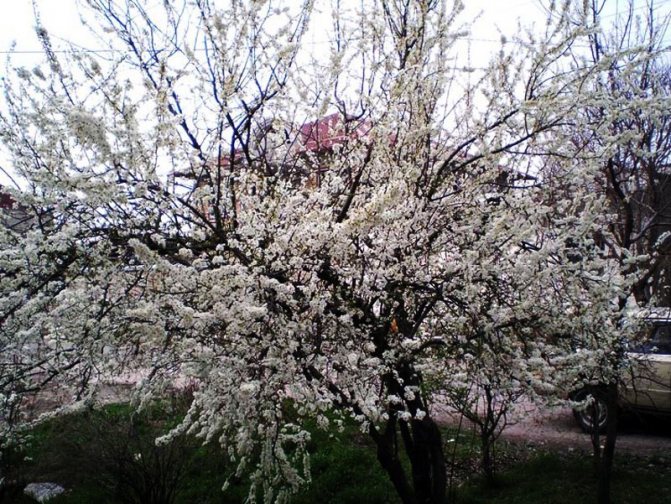

A plum tree that blooms first in the garden is important to protect from cold winds by choosing the right place for planting.
It should be noted that the proximity to some plants oppresses plum trees. These "unfriendly" neighbors include currants and raspberries.
It is useful to dig up the soil in the future garden, remove the roots of perennial weeds and larvae of harmful insects. Especially carefully it is necessary to select the larvae of the May beetle and the scoop, capable of destroying young trees.
Mark the places for planting holes with pegs, and sow the rest of the soil with lawn grass. The most suitable for these purposes is the bent-borer. It has a superficial root system that will not compete with the tree and take away nutrients from it.
Preparation of planting holes
The diameter of the landing pit is 1 m, and the depth is 70 cm. In clayey heavy soil, holes are dug no deeper than 50 cm. Poor, heavy soil is replaced by light and nutritious.
- The fertile soil of the upper soil layer, for convenience, is immediately poured into buckets, and the lower one is scattered over the site.
- Any organic matter is placed at the bottom of the pit with a layer of 20–25 cm: leaf litter, chopped branches, hay, mowed grass and grass, etc., and tamped.
- Several buckets of humus or compost, 500 g of deciduous tree ash, 200 g of bone meal are added to the pit, the collected fertile soil is poured so that the pit is filled to the top.
- The resulting mixture is watered abundantly to settle the soil.
After 2-3 weeks, a tree can be planted in this hole.


The seedling planting hole is filled with a nutritious soil mixture
If the groundwater on the site is closer than 1.5 meters, the plum tree should be planted on an artificial hill. To do this, outline a circle with a radius of at least 80 cm. A hill is formed inside the circle according to the pattern of filling the pit. The height of the hill is at least 50–70 cm.
Selection of seedlings with open and closed root systems
If you are planting plants with an open root system, it is best to choose one-year or two-year seedlings. Buy them in fruit nurseries, where a tree will be dug out in front of you.
Signs of healthy plants with open roots:
- The vaccination site is easy to determine. If it is impossible to find the place of transition of the rootstock into the scion on the seedling, it means that it was grown from a cuttings or root shoots. The grafted seedlings begin to bear fruit earlier.
- The foliage is green and healthy.
- The bark is free from damage and stains.
- Annual seedlings can have only one shoot with a thickness of at least 1.5 cm.
- Biennial plants have the rudiments of skeletal branches.
- The color of the bark corresponds to the varietal, that is, gray. The bark is smooth, without cracks or damage.
- Under the bark, if you make a small scratch, you can see a green cambium.
- The roots of the seedling are numerous, fibrous, light on the cut.
- There are no outgrowths, sagging, black spots on the roots, they do not break when bent.
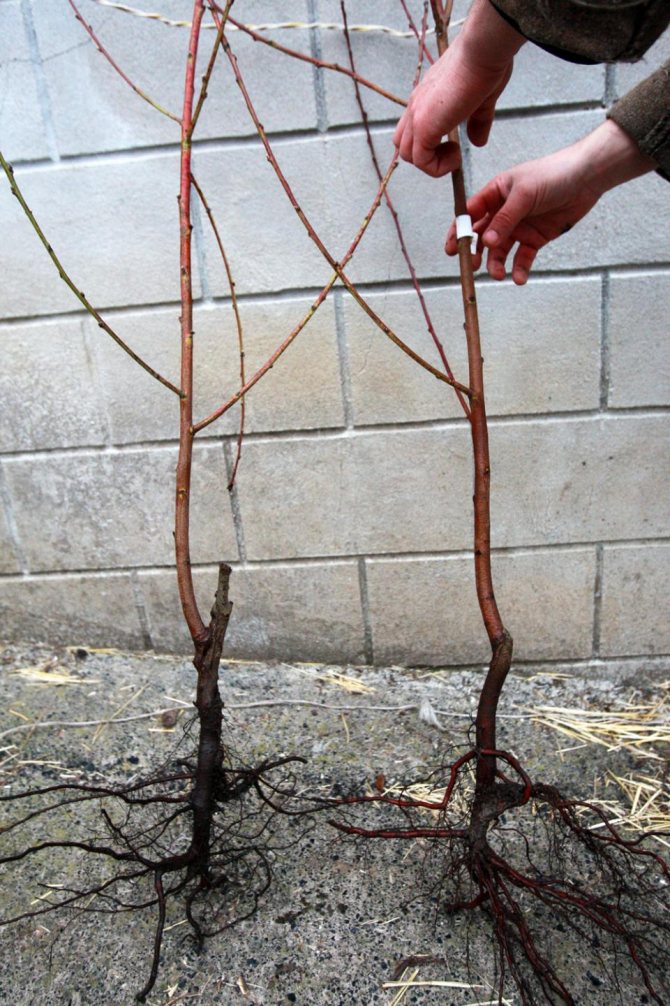

In two-year-old plum seedlings, the grafting site is clearly visible
Step-by-step process of planting seedlings with an open root system
- Before planting, place the roots of the selected seedlings in a solution of root-forming preparations (Kornevin, Heteroauxin, etc.) for 6–12 hours.
- Make holes for roots in pits or mounds prepared in advance.
- To fix the tree, drive a peg into the hole.
- Place the plant vertically in the hole, north of the peg, spreading the roots to the sides. The ends of the roots should lie loosely, without upward bends.
- Sprinkle with removed soil, shaking the seedling so that all voids around the roots are filled with soil.
- The root collar of the tree should remain 5-7 cm above the soil level.
- Make a hole around so that there is a hill around the stem.
- Water abundantly, pouring in water gradually, so that the earth around the roots settles and closes all the voids.
- Mulch the soil of the trunk circle with any organic mulch: husk of sunflower seeds, pine nuts, rotted sawdust, chopped dry grass, etc.
- Tie the seedling to the peg with a soft rope or twine, a figure-eight knot, so that the young bark is not damaged.
- The top of a one-year-old seedling without branches is cut at a height of 40-60 cm, and in two-year-old plants with rudiments of skeletal branches, all branches are shortened by 1/3.


In order not to damage the tender bark of the seedling, it is tied to a peg with a "figure eight" knot with a soft rope or elastic band
Fertilizers, except for those that were laid during the preparation of the landing pit, are not added to the Kuban comet when planting plums.
The selection and planting of seedlings with a closed root system is carried out according to the same scheme.... Just a few additional criteria should be added:
- The seedling must be grown in the exact container in which it is sold. This is evidenced by the roots growing through the drainage holes.
- The lump of earth in a pot is dense, does not fall apart, all braided with light thin roots.
- A small amount of weeds are allowed on the soil surface.
- If the soil in the container is covered with a layer of green moss, the seedling grows in the pot for a long time, the roots are intertwined too much.You do not need to take such a plant.
The advantage of planting such seedlings is the fact that when they are transferred to a permanent place, the roots are not damaged and the plant takes root faster.
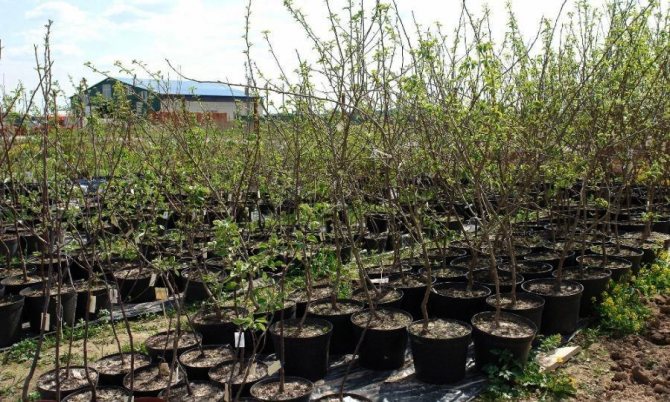

Seedlings with a closed root system can be planted throughout the season
Planting a plum tree - video
Growing seedlings of the Kuban comet from cuttings
Plum Kuban comet can be propagated independently by cuttings, both lignified and green. At the beginning of summer, cuttings of 20-30 cm are cut from an annual shoot. Each should have at least 2-3 buds. The lower part of it is placed for 12 hours in a solution of root-forming drugs (Kornevin, Heteroauxin), after making notches on the bark.
In a greenhouse or on a covered bed, a substrate is prepared from peat with sand (1: 1). Prepared cuttings are planted obliquely, leaving 1 bud on the surface, watered abundantly and covered with a film to maintain constant humidity. Protect from the sun using shading, making sure that the temperature in the cuttings is kept at the level of 25-30 ° C. The roots should appear in 2-3 weeks. As soon as signs of growth appear, the film can be removed.
If the cuttings were planted in containers of 3-5 liters, with the onset of frost, it is better to lower them into the basement and keep them until spring. In such a container, the seedling can grow for 1–2 years.
Before the onset of constant frosts, the bed is sprinkled with dry peat, with a layer of at least 10 cm, covered with agrospan, and on top with a film, protecting it from moisture. In the spring, rooted cuttings can be planted in a permanent place.
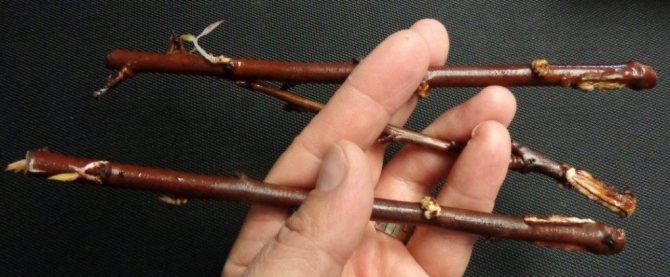

Before planting, plum cuttings should be held in a solution of preparations for better root formation.
Care for the variety "Kuban comet"
Trees are demanding on moisture, especially if the weather is dry, they need to be watered once a week from the moment the buds begin to bloom. When the time for fruit ripening comes, watering is stopped.


Cherry plum "Kuban comet" is excellent for the application of fertilizers. It is recommended to feed at least 3 times per season:
- When the buds open, organic fertilizers are applied.
- After the trees have faded, it is necessary to feed with phosphorus and potassium.
- In the fall, it is also necessary to apply nitrogen-containing fertilizers.
Loosening the soil around the cherry plum improves oxygen supply.
Important!
Weeds and organic debris should not be left under the cherry plum, since spores of harmful fungi are formed in them in large quantities, insects develop.
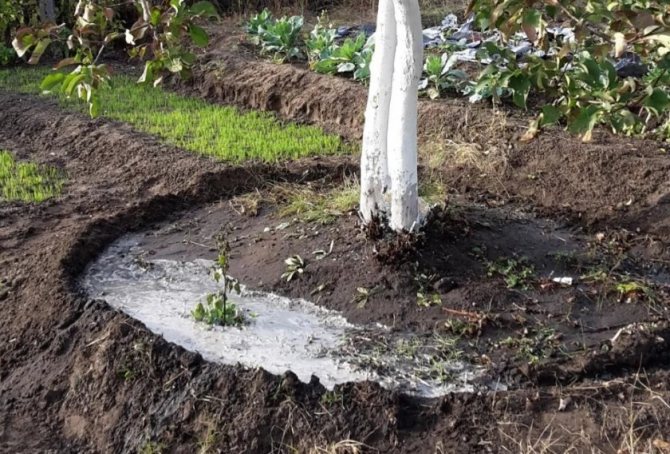

Pruning should be done in the spring and overgrowth and dried branches should be removed. If you don’t form a crown, it will grow as a bush, therefore, if you want to get a tree, you will need to prune it in order to form it twice a year.
Before the onset of cold weather, young plants should be covered with burlap, and old trees should be whitewashed with lime.


Varietal advantages and disadvantages
If we consider the advantages and disadvantages of the "Kuban comet" cherry plum, then the negative qualities pale before the positive characteristics. Judge for yourself, the variety is valued for such properties: Early entry of the tree into fruiting, usually it begins in the second year after planting. If the conditions in the first years of life were unfavorable, then the beginning of the collection of fruits will be shifted by one more season.
High and stable yield, increasing as the plant matures. An adult cherry plum, with proper care and the presence of pollinators, is capable of producing 150 kilograms of delicious berries per season. Large-fruited cherry plum, berries weigh up to 45 grams!
Early ripening of fruits. In the conditions of central Russia, already at the end of July, you can begin to feast on ripe berries. Duration of storage of fruits. This quality of berries is manifested in two forms: the ability to hang ripe on a bush for a long time without crumbling, and to lie in the refrigerator for a long time without spoilage (up to a month).The dense pulp of the fruits contributes to their high transportability, the berries can be safely transported over long distances.
The ripening ability of the harvested fruits allows picking even not quite ripe berries from the tree. This is especially important for summer residents who rarely go to the site. The versatility of fruits, they are suitable both for fresh consumption and for making jams, compotes, and other homemade preparations. Excellent fruit taste. Experts rate it at 4.6 on a five-point scale.
Good winter hardiness of the hybrid makes it possible to successfully cultivate the "Kuban comet" in conditions of risky farming. Vegetative propagation by cuttings makes it possible to obtain cherry plum seedlings on their own, share them with friends and acquaintances. Resistance to podoprevaniya root collar and cambium, as well as diseases of fruit crops, such as clasterosporium and monilial burn, allows you to get a crop of high commercial quality.
However, the negative qualities of the plant also need to be voiced in order to warn gardeners about possible troubles:
- the stone is separated from the fruit poorly;
- crushing of fruits is possible with excessive overloading of the tree without proper nutrition;
- high demands on the soil;
- partial self-fertility, requiring pollinators to complete the harvest;
- instability in relation to the water regime: cherry plum does not tolerate both drought and waterlogging.

